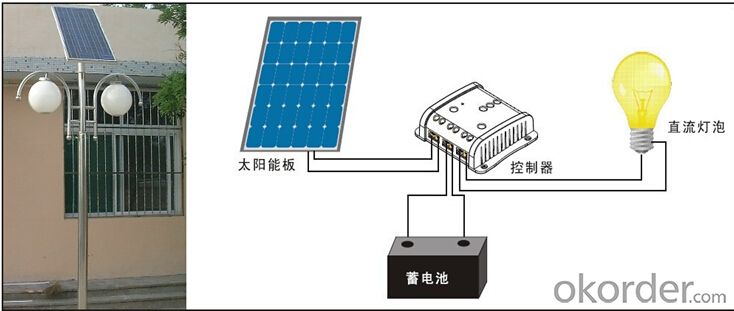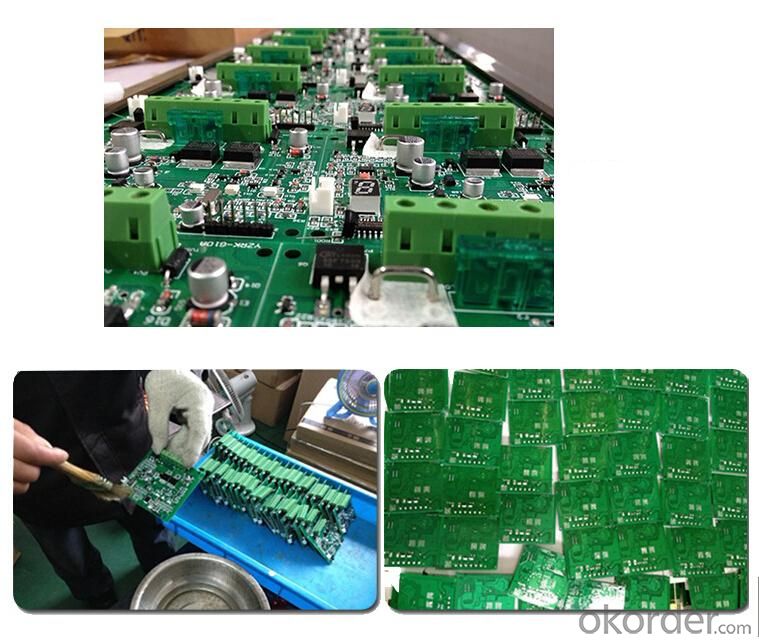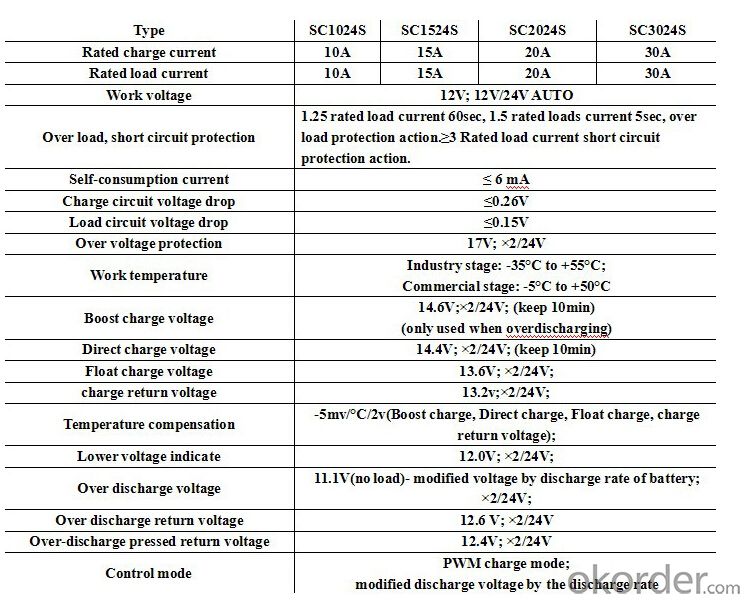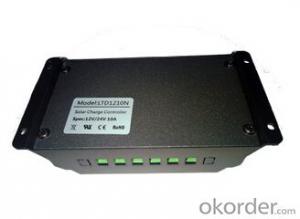BYGD Solar Charger Controllerfor Street light system Model SC1024S
- Loading Port:
- Shanghai
- Payment Terms:
- TT OR LC
- Min Order Qty:
- 10 unit
- Supply Capability:
- 50 unit/month
OKorder Service Pledge
OKorder Financial Service
You Might Also Like
1. Structure of BYGD Solar Charger Controller for Street light system Model SC1024S
This Solar Charger Controller is designed for street light system, which is updated with new technology to realize intelligentialization of control mode, and prolong service lifetime of all the components by improving the efficiency of operation. This Model is prior to the old generation in the aspects as follows: 12V/24V automatical adaption, control and set button changed into tact key, larger contact terminal can offer wire of 6 m2.
2. Main Features of BYGD Solar Charger Controllerfor Street light system Model SC1024S
◆ double LED digital display, clear for observation
◆ recharging mode by three phases
◆ PWM pulse modulated recharging technology
◆set light-dependent control and 1-13hous time control
◆short circuit protection, overvoltage protection, overcurrent protection and lighting protection
◆standy current no more than 5mA
3. BYGD Solar Charger Controllerfor Street light system Model SC1024S Images


4.BYGD Solar Charger Controllerfor Street light system Model SC1024S Specification
External Size:133mm×70mm
Mounting hole Size:126mm×50mm

5. FAQ
(1) Why use PWM charge mode?
Our solar charger controller uses PWM in the main circuit for charge in order to reduce the voltage loss of the loop, which can improve the charging efficiency by 3-6% compared to the ones not useing PWM.
(2) What is the advantage of double digital display?
Double digital display make the code more clear and reasonable to show the correct mode so as to avoid misunderstanding.
(3)Is this new model more expensive that the old one?
Surely yes, because new model has the terminal bigger than that of the old model, which costs a few times more, the price of the product will be increased accrodingly.
- Q:Can a solar controller be used with a solar-powered waste management system?
- Yes, a solar controller can be used with a solar-powered waste management system. A solar controller is responsible for regulating the energy flow between the solar panels and the battery or load. In a solar-powered waste management system, the solar controller can efficiently manage the power generated by the solar panels to charge the batteries used in the system or power the waste management equipment directly. This ensures optimal utilization of solar energy and enhances the overall efficiency and performance of the system.
- Q:Can a solar controller be used with a solar-powered educational facility?
- Yes, a solar controller can be used with a solar-powered educational facility. A solar controller is an essential component of a solar power system as it regulates the flow of electricity from the solar panels to the batteries, ensuring efficient and safe charging. In a solar-powered educational facility, a solar controller would be necessary to manage the power generated by the solar panels and distribute it to the various electrical systems within the facility, such as lighting, heating, and cooling. Additionally, a solar controller helps monitor the battery health and prevents overcharging or discharging, maximizing the lifespan of the batteries.
- Q:Can a solar controller be used with solar panels that are connected to a solar lighting system?
- Yes, a solar controller can be used with solar panels that are connected to a solar lighting system. The solar controller helps regulate and optimize the charging of batteries by controlling the flow of electricity from the solar panels. This ensures efficient charging and protects the batteries from overcharging or discharging, enhancing the overall performance and lifespan of the solar lighting system.
- Q:Can a solar controller be used with a solar-powered internet connection?
- Yes, a solar controller can be used with a solar-powered internet connection. A solar controller regulates the charging and discharging of batteries in a solar power system, ensuring optimal performance and longer battery life. It can be employed in a solar-powered internet setup to manage the charging of batteries that store excess solar energy for powering internet equipment, ensuring a reliable and sustainable internet connection.
- Q:Can a solar controller be used with PWM (Pulse Width Modulation) technology?
- Yes, a solar controller can be used with PWM (Pulse Width Modulation) technology. PWM technology is commonly used in solar charge controllers to regulate the charging of batteries by varying the width of the charging pulses. This helps to maintain a steady and efficient charging process, extending the lifespan of the batteries.
- Q:Can a solar controller be used in a portable solar system?
- Yes, a solar controller can be used in a portable solar system.
- Q:How do you determine the right size of solar controller for a system?
- When determining the appropriate size of a solar controller for a system, several important factors must be taken into account. First and foremost, it is necessary to compute the maximum current and voltage that will be produced by the solar panels. This can be achieved by multiplying the panels' maximum current rating by their maximum voltage output. Subsequently, it is essential to establish the maximum current and voltage capacity of the charge controller. This information is typically provided in the manufacturer's product specifications or datasheet. Ideally, the solar controller should have a current and voltage rating that exceeds the maximum values generated by the solar panels. This ensures that the controller can effectively manage and regulate the energy generated by the panels without becoming overwhelmed. Moreover, it is advisable to consider any future expansion plans for the system. If there are intentions to add more solar panels in the future, it is prudent to select a solar controller with a higher capacity than what the current system requires. It is important to highlight that the size of the solar controller should also be compatible with the other components of the system, such as the battery bank and inverter. Consequently, it is crucial to ensure that all components are appropriately matched and compatible with one another. To summarize, determining the appropriate size of a solar controller entails calculating the maximum current and voltage generated by the solar panels, comparing these values with the specifications of the controller, and taking into account any future expansion plans. Consulting a solar professional or referring to manufacturer guidelines is recommended to ensure accurate sizing for your specific system.
- Q:What is the maximum input voltage that a solar controller can handle?
- The maximum input voltage that a solar controller can handle varies depending on the specific model and manufacturer. However, in general, most solar controllers can handle input voltages up to 150 volts DC. It is important to check the specifications provided by the manufacturer of the solar controller to ensure that the input voltage of your solar panel system is within the maximum limit supported by the controller. Exceeding the maximum input voltage can potentially damage the controller and may lead to system failure.
- Q:Can a solar controller be used with a grid-tied solar system?
- No, a solar controller is not typically used with a grid-tied solar system. Grid-tied systems are designed to directly connect to the electrical grid, allowing excess energy to be fed back into the grid. Solar controllers, on the other hand, are commonly used in off-grid systems to regulate and optimize the charging of batteries.
- Q:What is the meaning of the DC load above the solar controller?
- Because the controller output function, such as the switch, then the battery is DC energy, so if the direct output, can only take the DC load, can work properly, if you want to work on the AC load, then the need to connect the controller output DC Inverter, so that the AC load can work. My space has a lot of information about the solar system, welcome to come to view
1. Manufacturer Overview |
|
|---|---|
| Location | |
| Year Established | |
| Annual Output Value | |
| Main Markets | |
| Company Certifications | |
2. Manufacturer Certificates |
|
|---|---|
| a) Certification Name | |
| Range | |
| Reference | |
| Validity Period | |
3. Manufacturer Capability |
|
|---|---|
| a)Trade Capacity | |
| Nearest Port | |
| Export Percentage | |
| No.of Employees in Trade Department | |
| Language Spoken: | |
| b)Factory Information | |
| Factory Size: | |
| No. of Production Lines | |
| Contract Manufacturing | |
| Product Price Range | |
Send your message to us
BYGD Solar Charger Controllerfor Street light system Model SC1024S
- Loading Port:
- Shanghai
- Payment Terms:
- TT OR LC
- Min Order Qty:
- 10 unit
- Supply Capability:
- 50 unit/month
OKorder Service Pledge
OKorder Financial Service
Similar products
New products
Hot products
Related keywords





























